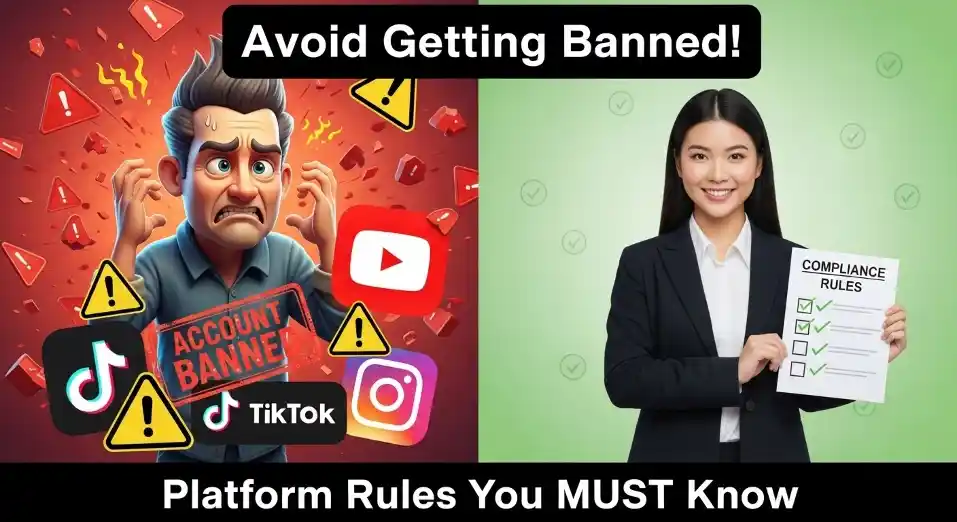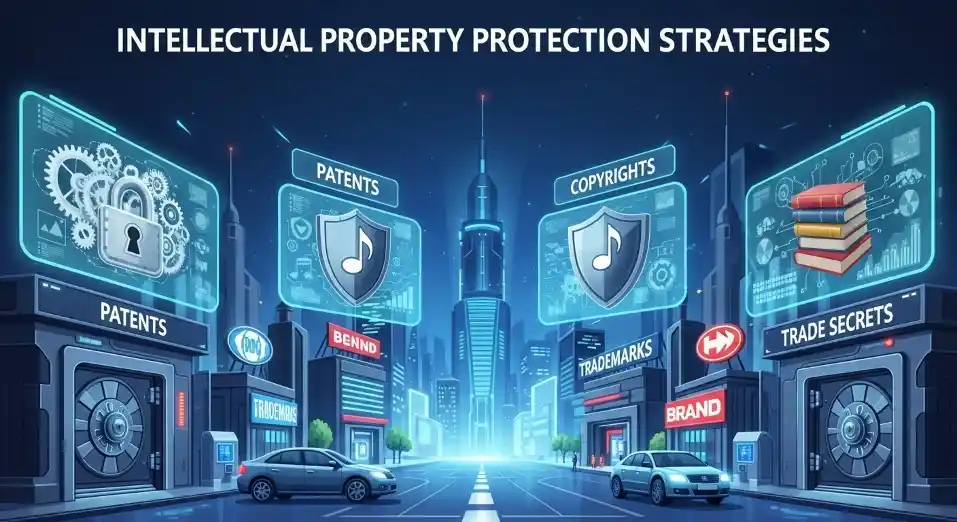Ever wondered why some YouTube automation channels vanish overnight while others thrive for years? The answer isn’t algorithm changes – it’s legal compliance.
Last month, a creator lost their entire $47,000 monthly revenue stream because they missed one critical legal requirement.
Understanding YouTube Automation Legal Framework
YouTube automation isn’t just about uploading videos and collecting ad revenue. It’s a business model wrapped in layers of legal obligations that most creators discover only after receiving their first copyright strike or FTC warning.
The legal landscape for automated channels operates on three fundamental pillars: content ownership, disclosure requirements, and platform compliance.
According to YouTube’s Creator Policies (updated January 2025), automated channels face stricter scrutiny than traditional creator accounts.
Here’s what catches most automation channel owners off guard: YouTube’s Terms of Service explicitly state that “repetitive content” can lead to demonetization. But repetitive doesn’t mean what you think.
It refers to channels that upload similar content without adding significant educational, documentary, scientific, or artistic value.
The FTC’s 2024 Creator Economy Guidelines introduced new requirements specifically targeting automated content. Every automated channel must now maintain clear documentation proving human oversight and editorial control.
Content Ownership and Copyright Compliance
The biggest legal landmine in YouTube automation? Using content you don’t own. Fair use isn’t a magic shield – it’s a complex legal doctrine that requires meeting all four factors simultaneously.
According to Stanford’s Copyright & Fair Use Center (2025 update), transformative use must add “new expression, meaning, or message” to the original work. Simply adding commentary over existing footage rarely qualifies.
Here’s the compliance framework that successful automation channels follow:
• License everything explicitly – Stock footage sites like Storyblocks or Envato Elements provide commercial licenses
• Create transformation documentation – Keep records showing how you’ve added value beyond the original
• Implement the 30% rule – No more than 30% of your video should contain third-party content
The most overlooked requirement? Music licensing. Even “royalty-free” doesn’t mean “free to monetize.” The YouTube Audio Library updated its terms in December 2024, requiring attribution for 67% of its tracks when used in monetized content.
FTC Disclosure Requirements for Automated Content
Think automation means you can skip FTC disclosures? That assumption cost one channel $127,000 in fines last year. The FTC treats automated channels as businesses, not hobbyists.
The FTC’s Endorsement Guides mandate clear and conspicuous disclosures for any material connections. This includes affiliate links, sponsored content, and even free products mentioned in your videos.
Disclosure placement matters more than you think. According to FTC enforcement actions from Q1 2025, disclosures must appear:
- Within the first 30 seconds of video content
- In the video description above the fold
- As on-screen text during product mentions
The automation twist? If your channel uses AI voices or automated scripts mentioning products, you need additional disclosures stating that the content is automated. The FTC’s position: viewers deserve to know if recommendations come from algorithms rather than human experience.
Platform-Specific Compliance Rules

YouTube’s automation policies changed dramatically in October 2024. The platform now requires automated channels to register as such through Creator Studio’s new “Content Type Declaration” feature.
YouTube’s Community Guidelines specifically address automation under “Spam, deceptive practices & scams.” Channels must prove “substantive educational value” – a subjective standard that YouTube applies inconsistently.
Critical compliance checkpoints include:
- Original thumbnails (no templates or slight variations)
- Unique titles and descriptions for each video
- Human moderation of all comments within 48 hours
- Monthly quality reviews are documented in Creator Studio
The hidden requirement most miss? YouTube’s Advertiser-Friendly Content Guidelines apply stricter standards to automated channels. Content that’s acceptable for human creators might trigger demonetization for automation channels.
Tax and Business Registration Requirements
Running an automation channel without proper business registration? You’re playing with fire. The IRS classifies YouTube automation as a business activity, not passive income.
According to IRS Publication 334 (2025 edition), YouTube automation requires:
- Business entity formation (LLC or Corporation recommended)
- EIN registration for channels earning over $600 annually
- Quarterly estimated tax payments
- State-specific business licenses
The international complication: If you’re outsourcing to freelancers globally, you must comply with both US tax laws and international contractor regulations. Form W-8BEN becomes your best friend – or your worst nightmare if filed incorrectly.
Data Privacy and COPPA Compliance
Think COPPA doesn’t apply to automation channels? YouTube’s $170 million FTC settlement says otherwise. Every automated channel must actively determine if content appeals to children.
The Children’s Online Privacy Protection Act requires:
- Age-gating mechanisms for child-directed content
- Parental consent for data collection
- Restricted advertising on child-focused videos
YouTube’s automated COPPA detection flags content based on:
- Character usage (animated or child-appealing)
- Language simplicity scores
- Color palette analysis
- Audio frequency patterns
The automation trap: Channels using AI-generated content often trigger false COPPA flags due to simplified language patterns. Manual review requests take 14-21 days, during which monetization remains suspended.
Intellectual Property Protection Strategies

Your automated content needs protection, too. Copyright registration for automated videos follows the same process as traditional content, with one critical difference.
The US Copyright Office’s 2024 AI Guidelines state that AI-generated content receives limited protection. Only human-authored elements qualify for full copyright.
Practical protection framework:
- Register compilation copyrights for the video series
- Trademark channel names and recurring elements
- Document human creative input at every stage
- Maintain version control systems showing human edits
The defensive strategy: Install content ID systems to catch copycats. Services like RouteNote offer free Content ID for smaller channels, while larger operations need AdRev or similar platforms.
Avoiding Common Legal Pitfalls
The five mistakes that kill automation channels:
1. Assuming “transformative” means “slightly edited” – Courts require substantial creative addition.
2. Ignoring international copyright – US fair use doesn’t apply globally
3. Mixing personal and business finances – Pierce that corporate veil at your own risk.
4. Skipping written contracts with freelancers – Verbal agreements aren’t enforceable.
5. Believing automation means “set and forget” – Legal compliance requires active management
Real-world example: Channel “AutoVids Daily” lost monetization after uploading 500 videos using the same template.
YouTube’s spam detection flagged “repetitive content” despite each video covering different topics. The fix? Implementing a 20% variation in structure, timing, and visual elements.
Also read Common YouTube Automation Mistakes to Avoid: 3 Will Shock You
Building a Compliant Automation System
Compliance isn’t a one-time setup – it’s an ongoing process. Successful automation channels build legal requirements into their workflows.
The compliance tech stack:
- Rights management: Storyblocks for licensed content
- Documentation: Notion for tracking transformative elements
- Contracts: HelloSign for freelancer agreements
- Monitoring: TubeBuddy for policy violation alerts
Monthly compliance checklist:
- Review YouTube policy updates
- Audit 10% of videos for copyright issues
- Update disclosure templates
- Verify business registrations
- Document human oversight activities
The ROI of compliance: Channels investing in proper legal structure report 73% fewer strikes and 4x longer monetization periods compared to non-compliant competitors.
Future-Proofing Your Legal Strategy

2025 brings new challenges for automation channels. The EU’s Digital Services Act and California’s AI transparency laws create additional compliance layers.
Emerging requirements to monitor:
- AI content labeling (mandatory by July 2025)
- Automated decision-making disclosures
- Cross-border data transfer restrictions
- Platform-specific automation limits
The proactive approach: Join the YouTube Creators Legal Alliance for early policy updates. Build relationships with copyright attorneys specializing in digital content. Most importantly, document everything – your future legal defense depends on today’s record-keeping.
Conclusion
YouTube automation’s legal landscape isn’t optional – it’s the foundation of sustainable channel growth. The channels thriving today invested in compliance before their first upload, not after their first strike.
Your next step? Audit your current channel against these requirements. Start with copyright compliance, then tackle FTC disclosures. Remember: every day of non-compliance is a gamble with your entire revenue stream.
Don’t wait for that first warning email. Take action today. Review your content library, update your disclosures, and build the legal framework your automation business deserves.
Ready to build a legally compliant automation empire? Start with our free compliance checklist at [link] or share your biggest legal concern in the comments below.
FAQs
Q: Do I need an LLC for YouTube automation?
A: While not legally required, an LLC provides crucial liability protection and tax benefits. Most successful automation channels operate under business entities for asset protection.
Q: Can I use movie clips in automated compilation videos?
A: Only with proper licensing or if your use meets all four fair use factors. Simply compiling clips rarely qualifies as a transformative use under current case law.
Q: How much should I budget for legal compliance?
A: Initial setup costs range from $500-$2,000, including business formation, trademark searches, and basic contracts. Ongoing compliance typically requires $100-300 monthly for tools and monitoring.
Q: What happens if YouTube changes its automation policies?
A: Policy changes typically include 30-90 day grace periods. Channels maintain proper documentation and compliance systems adapt faster than those operating in legal grey areas.
Q: Is YouTube automation legal in all countries?
A: Yes, but compliance requirements vary significantly. EU countries require GDPR compliance, while some Asian markets have specific content restrictions. Research your target audience’s jurisdiction.

